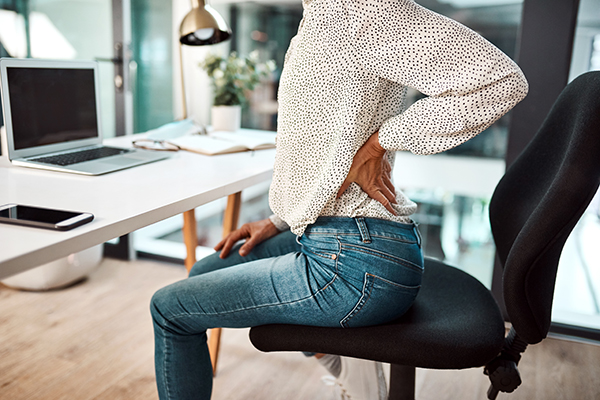How to Improve Bad Posture With Exercise

If your spine resembles a question mark while you’re sitting or standing, it’s your body’s way of screaming, “WTF are you doing to me?!” Knowing which exercises improve bad posture is crucial to improving your overall health and fitness.
“Sitting is the new smoking,” says Steve Maxwell, a strength and conditioning coach and expert in posture and joint mobility. “It’s that harmful.”
Sitting puts the body in an unnatural position and throws off its alignment. Sitting leads to shortened (taught) hamstrings and hip flexors, and a hunched posture that increases stress on the spine.
And don’t forget “text neck,” that phenomenon of the forward-leading head caused by constantly staring, zombie-style, at our phones. “It’s all a recipe for really bad posture,” says Maxwell.
The good news is bad posture is fixable, even after years of slouching. Check out these five strategies…
1. Sort Out Your Seating
To fix bad posture, kick the habits that got you there in the first place.
Switch out your desk chair for one that forces you to sit with a straight back. “Anything is better than a regular chair, but you can still slouch,” advises Maxwell.
If a new chair isn’t in the cards, prop pillows or supports behind your back in a regular chair so you’re forced to sit straight. Or, better yet: Find a way to stand during part of your workday—for instance, with a standing desk.
2. Try Yoga

Among the many benefits yoga offers, its emphasis on strength and flexibility speaks directly to a healthy posture.
Several poses within the practice help alleviate the neck, shoulder, and lower-back pain that often accompany an askance stance. These poses relieve pressure, muscle tightness, and increase mobility while decreasing the chance of injury.
Poses like happy baby and the reclined spinal twist are good for stretching and strengthening the hips and lower back. Others, like eagle arms and threading the needle, promote proper upper-body alignment.
3. Crawl Around Like a Baby
Maxwell is also about getting back to basics when seeking exercises to improve posture. He specializes in mobility work that involves mimicking the movements of babies to alleviate tension and un-learn unhealthy postural habits.
“It’s very restorative to flexibility, and it quickly brings back mobility to the spine,” he says. His program incorporates cross-crawl exercises and other movements he believes not only stimulate muscles but also the nervous system as well.
4. Work Your Core

Maxwell’s an avid athlete and trainer, but he discourages weightlifting or other heavy resistance training for those with bad posture.
“The problem with weightlifting is that it makes bad posture worse because there’s added pressure on the body,” he says. Instead, in addition to yoga, try walking or, if you’re up for it, abdominal exercises.
“Poor movement patterns cause even more imbalances in the body,” Maxwell says. So, start fixing bad posture by focusing on strengthening the core muscles and posture moves that can reinforce your glutes, latissimi dorsi, and rhomboid (mid-back) muscles.
As for products that promise to improve posture, like back braces? Just say no. “These devices don’t teach your body to do the right things,” he says. “Learning to move properly — with stability, strength, and good posture — is the only way to go.”
5. Go Rolfing
Run out of exercises to improve posture and still suffer alignment issues? Maxwell says it’s time to seek out an expert in Rolfing.
Developed by biochemist Ida Pauline Rolf, Rolfing is a holistic form of bodywork that involves manipulation of the body’s soft tissue to rebalance and realign the structure in the fascia (the fibrous connective tissue found throughout the body).
Healthy fascia can move without restriction, but tight fascia can restrict normal movement and lead to problems, including bad posture.
“Rolfing pretty much saved me,” says Maxwell, who’s also a former wrestler and Jiu-Jitsu expert. It’s not as common as, say, deep tissue massage, but therapists who practice this extreme form of massage must go through at least 10,000 hours of massage therapy and three years of school to qualify for certification. Find one who will prescribe a Rolfing regimen after a full check-up.
Why Is Posture So Important?

Posture affects all human function, both consciously and unconsciously, from breathing to thinking, according to a study by the National Institutes of Health.
Pain avoidance
The most obvious consequences of bad posture are back and shoulder aches, the kind that keep you reaching for painkillers.
“The musculoskeletal system relies on the body being balanced,” says orthopedic surgeon Joanne Halbrecht, M.D., who practices sports medicine in Boulder, Colo. “If your posture is incorrect, it changes your center of gravity, and gravity is working on us 24/7.”
Fitness performance
Studies have also found that adopting an adverse posture can stimulate production of stress hormones like cortisol. That can hamper your weight-loss efforts, among other negative impacts.
“It’s like you’re in fight-or-flight mode 24/7,” Maxwell says. “Being in stress most of the time can possibly shave years off your life.”
On the flip side, good posture can boost your workouts. That’s because proper head-to-toe alignment allows your muscles to work more efficiently and synergistically, thereby overcoming fatigue and giving you more energy to dedicate to your workout — and your life.
Appearance and confidence
Researchers from Harvard University believe that striking certain postures in the workplace “increases explicit and implicit feelings of power and dominance, risk-taking behavior, action orientation, pain tolerance, and testosterone (the dominance hormone), while reducing stress, anxiety, and cortisol.”
They asked participants to adopt “power poses:” sitting with their feet on a desk and their hands clasped behind their heads; and then standing up and leaning over a desk with their hands on it. Participants of both sexes who performed the poses with good posture said they felt more powerful. That result was borne out in saliva samples, too: Those who struck the poses saw testosterone increase 19 percent and cortisol decrease 25 percent.
“These postures reflect power, they also then produce it,” the researchers wrote.
